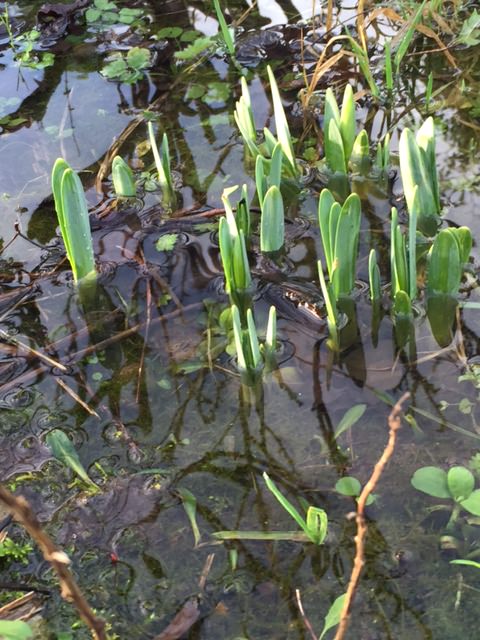If you’ve been affected by the floods, you have my deepest sympathies which is why I’ve written this article about how to bring your garden back from the flood. The feeling of devastation is untellable when your house has been ruined so I know the state of the garden, whilst it might be causing you some concern, will not be at the top of your priority list. All the same, when the water levels have receded enough to make it practical to get into the garden, it still needs some attention as well.
Action these points now to save time and effort later.
Get rid of the sludge whilst it is still wet and movable.
The first and most urgent thing to do is to get rid of the debris and sludge that has been left behind by the flood waters, which is much easier to do when it is wet. If left untended, it makes surfaces slippery and therefore dangerous to walk on, is potentially contaminated with chemicals, oil and/or sewage and can stain some of the more porous sand stone paving. It is relatively straight forward to rinse the sludge off paths and patios with fresh water and a broom or a power washer so long as it is done whilst it is still wet but it will require a lot more effort and elbow-grease to get rid of it when it has dried out. It would also be sensible to avail of the skips supplied for flood debris disposal whilst they are around, to get rid of all opened bags of compost and the contents of compost bins which could have been contaminated.
Look to your pots
It would also be prudent to get rid of the contents of any pots that have been in contact with the flood water, especially if they have no plants in them or have plants in them that could do with refreshing. Where you have a potentially contaminated pot that contains a much-loved plant or has a permanent occupant, just keep any eye on it as spring comes. The thing you are looking for is signs of stress (which will show up as discolouration of the leaves) that could be caused by chemical or oil contamination. Hopefully, the plant within the pot will have escaped without damage but if not, you’ll know why and what to do with it.
Emergency rescue for favourite plants
Although it is not a good idea to do any digging in water logged soil, if you have a particularly favourite plant in the ground it would upset you to lose, dig a trench round its roots to help speed up drainage. This should only be used for plants it would be very difficult or impossible to replace due to the compaction damage you will do to the surrounding soil by walking on it. Once these types of jobs have been done, you can wait till the garden has dried out before tackling other areas. Some tips and techniques are given below to help get your garden back into good condition.

Common sense, the sense least common.
Keep to the paths and stay off all soil and the lawn until the water has drained fully away. This is because walking on water-logged soil will compact it by destroying its structure, which you will have to work very hard later on to restore. This is particularly important if you already have a heavy clay soil. If you do have to leave the path, put down a board, plank or create temporary stepping stones, with spare bricks.
Restoration jobs that will make all the difference later.
Wash the plants
Wash all silt and debris off the leaves of plants with clean water if rain doesn’t do it for you within a month. If silt is allowed to remain on the leaves, it will prevent the plant from making full use of the sun which will reduce its ability to make food and therefore, thrive. If possible, wash the silt and debris off the lawn as well.
Aerate the lawn with a hollow tine aerator or else use your garden fork to create small holes into the turf. This will help with drainage and getting air back into the root zone. You could just leave the holes or brush lawn sand in.
Improve fertility
Once the soil in the planting areas has drained fully and is back to its normal texture, apply a generous top-dressing of well-rotted organic matter to help return the soil to good fertility because, depending on the length the floodwater was there for, earthworms and other soil organisms could have been drowned. To help boost soil fertility quickly and get the plants going you could also give the plants an application of a general purpose fertilizer once growth restarts.
Check for a soil cap
Have a good look to see whether the receding water has created a cap on the soil. This will become apparent if you see puddles of water forming on the soil after it has rained. If you take a garden fork and break through the top few centimetres of soil and find that it is quite dry below, the soil has a cap which is preventing water from percolating downwards. If a cap has formed, it is easy to break it by lightly forking the surface of the soil.
Throw any contaminated veg away
If any produce from the vegetable garden was in contact with the flood, it is advisable not to eat it because you have no idea what contaminants might also have been in the water.
If you think the flood water has killed anything, you can check whether a shrub and or tree is alive by scraping back a little of the bark on a branch or the stem with your finger nail and having a look. If the plant is living, it will be green underneath so despite outward appearances, don’t condemn a plant too quickly.
Ray of hope
Finally, give yourself a bit of a boost and plant up a couple of pots (with clean compost) with something that will bring a dash of colour and a ray of hope in the days of recovery ahead.
If you enjoyed this article and want to learn more then feel free to contact me.
You can also learn more about how to prepare your garden if floods are threatened from the Environment Agency by clicking here.


